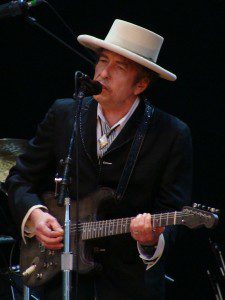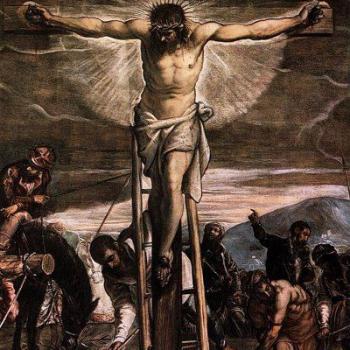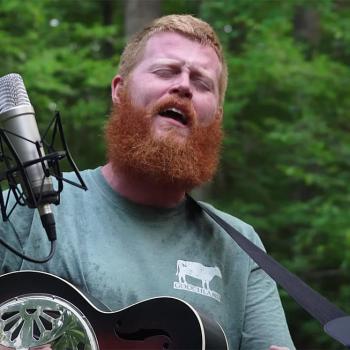 Bob Dylan has a new album coming out at the end of the month: Triplicate. It’s a triple album–the equivalent of three CDs–and it’s more standards, his third album in a row covering Sinatra-style songs from the 1940s, 1950s, and early 1960s. Stardust. Stormy Weather. Sentimental Journey. (Go to the Amazon link above to see what songs are on the album. You can buy some of them individually already, though the album won’t be released until March 31.)
Bob Dylan has a new album coming out at the end of the month: Triplicate. It’s a triple album–the equivalent of three CDs–and it’s more standards, his third album in a row covering Sinatra-style songs from the 1940s, 1950s, and early 1960s. Stardust. Stormy Weather. Sentimental Journey. (Go to the Amazon link above to see what songs are on the album. You can buy some of them individually already, though the album won’t be released until March 31.)
In conjunction with the album, the Nobel laureate has posted on his website a wide-ranging and fascinating interview with author and TV producer Bill Flanagan.
He talks about Minnesota, his childhood, his early career, but mostly he talks music. He explains what he loves about these songs, while also showing that he keeps up with contemporary music. Showing an encyclopedic knowledge of music, Dylan talks chords, charts, styles, and phrasing. We see Dylan as a performer and also as a music producer, explaining what he looks for in a drummer, what he tries to do in the studio, explaining how he sequences the songs on his albums.
For an overview of the interview–nice phrase, if I do say so myself–read this. From Rolling Stone, here is a link to “Bob Dylan’s Surprise, Extensive New Interview: 9 Things We Learned.”
After the jump, a link to the interview itself. Read it all, but I quote his answers to only two questions: one on the different styles in his singing; and one giving his reflections on the early days of rock ‘n’ roll.
From Q&A with Bill Flanagan | The Official Bob Dylan Site:
You do some great singing here – “When the World Was Young,” “These Foolish Things” – which begs the question, if you can sing like that, why don’t you always sing like that?
Depends what kind of song it is. “When the World Was Young,” “These Foolish Things,” are conversational songs. You don’t want to be spitting the words out in a crude way. That would be unthinkable. The emphasis is different and there is no reason to force the vernacular. “An airline ticket to romantic places” is a contrasting type of phraseology, than, say, “bury my body by the highway side.” The intonation is different, more circumspectual, more internal. . . .
“Braggin’” was done by Duke Ellington in 1938 – it’s the sort of big band swinging blues that led directly to rock and roll. As a kid, did rock and roll feel like a new thing to you or an extension of what was already going on?
Rock and roll was indeed an extension of what was going on – the big swinging bands – Ray Noble, Will Bradley, Glenn Miller, I listened to that music before I heard Elvis Presley. But rock and roll was high energy, explosive and cut down. It was skeleton music, came out of the darkness and rode in on the atom bomb and the artists were star headed like mystical Gods. Rhythm and blues, country and western, bluegrass and gospel were always there – but it was compartmentalized – it was great but it wasn’t dangerous. Rock and roll was a dangerous weapon, chrome plated, it exploded like the speed of light, it reflected the times, especially the presence of the atomic bomb which had preceded it by several years. Back then people feared the end of time. The big showdown between capitalism and communism was on the horizon. Rock and roll made you oblivious to the fear, busted down the barriers that race and religion, ideologies put up. We lived under a death cloud; the air was radioactive. There was no tomorrow, any day it could all be over, life was cheap. That was the feeling at the time and I’m not exaggerating. Doo-wop was the counterpart to rock and roll. Songs like “In the Still of the Night,” “Earth Angel,” “Thousand Miles Away,” those songs balanced things out, they were heartfelt and melancholy for a world that didn’t seem to have a heart. The doo-wop groups might have been an extension, too, of the Ink Spots and gospel music, but it didn’t matter; that was brand new too. Groups like the Five Satins and the Meadowlarks seemed to be singing from some imaginary street corner down the block. Jerry Lee Lewis came in like a streaking comet from some far away galaxy. Rock and roll was atomic powered, all zoom and doom. It didn’t seem like an extension of anything but it probably was.
Photo by Alberto Cabello from Vitoria Gasteiz (Bob Dylan) [CC BY 2.0 (http://creativecommons.org/licenses/by/2.0)], via Wikimedia Commons















